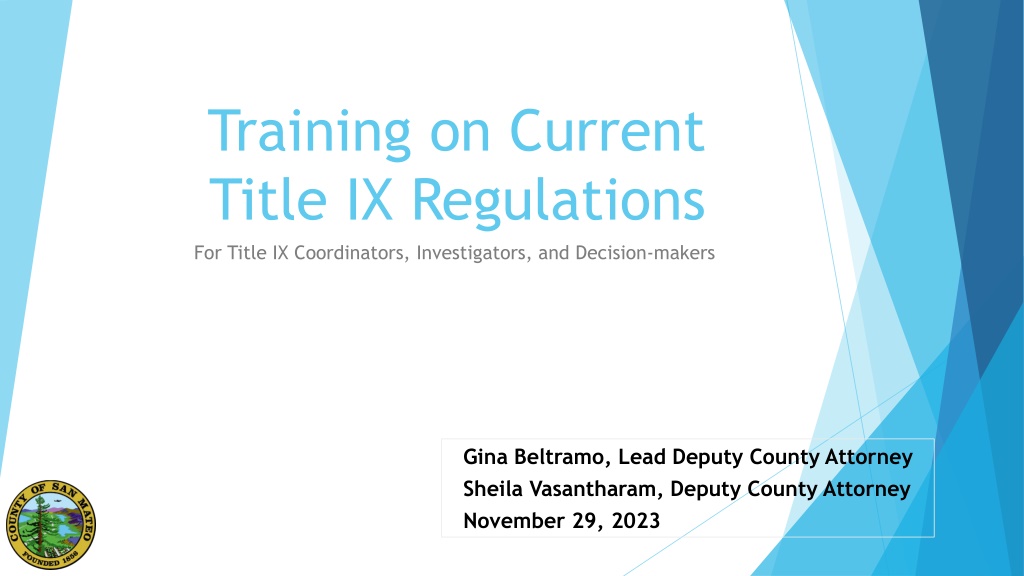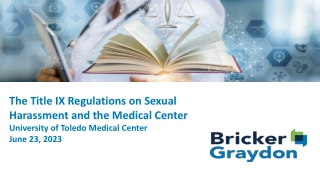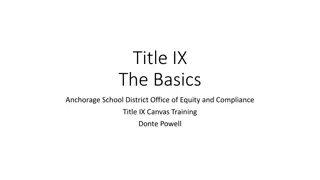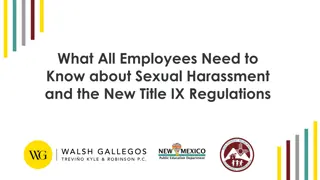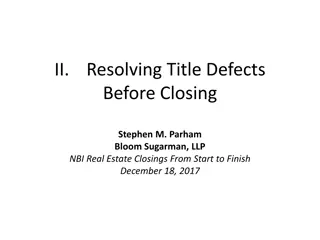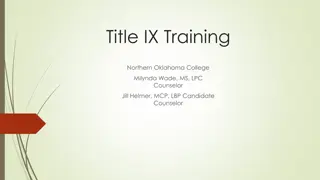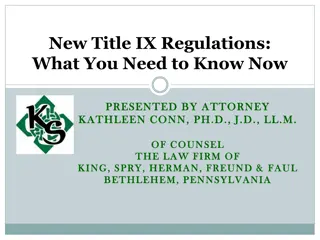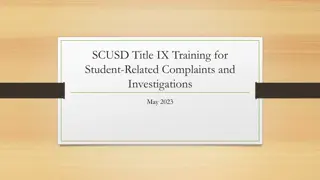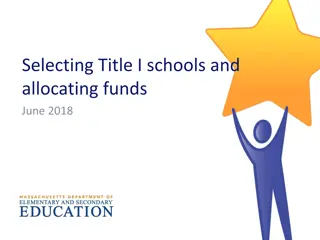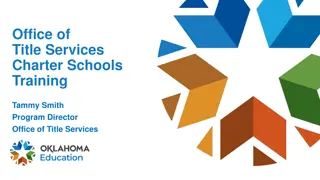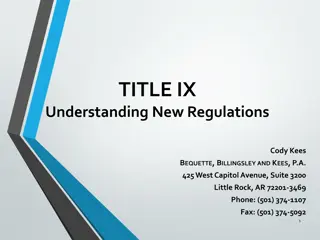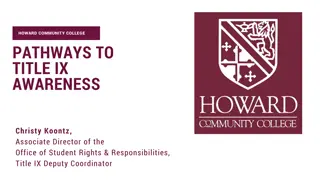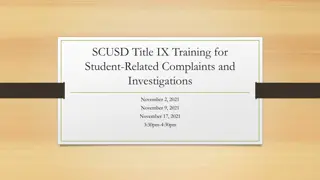Understanding Current Title IX Regulations
This training covers the essential aspects of Title IX regulations for coordinators, investigators, and decision-makers, providing insights into the law, investigative and decision-making processes, and record-keeping obligations. It also delves into the history and evolution of Title IX, emphasizing its role in preventing discrimination based on sex in educational settings receiving federal financial assistance.
Download Presentation

Please find below an Image/Link to download the presentation.
The content on the website is provided AS IS for your information and personal use only. It may not be sold, licensed, or shared on other websites without obtaining consent from the author. Download presentation by click this link. If you encounter any issues during the download, it is possible that the publisher has removed the file from their server.
E N D
Presentation Transcript
Training on Current Title IX Regulations For Title IX Coordinators, Investigators, and Decision-makers Gina Beltramo, Lead Deputy County Attorney Sheila Vasantharam, Deputy County Attorney November 29, 2023
What We Will Cover Introductions 1. What is Title IX Law 2. What Triggers a Title IX Investigation 3. The Obligations of a District 4. The Investigative Process 5. The Decision Making Process 6. Record Keeping Obligations 7.
INTRODUCTIONS 1. What District are you with 2. What is your role in the Title IX process (Coordinator/Investigator/Decision Maker) 3. How long have you been in that role 4. Are you involved in any pending Title IX complaints/how many Title IX matters have you worked on?
What is Title IX? No person in the United States shall, on the basis of sex, be excluded from participation in, be denied the benefits of, or be subjected to discrimination under any educational program or activity receiving federal financial assistance. 20 U.S.C. 1681 and 34 C.F.R. Part 106
Title IX Over the Years Title IX is a Federal law, passed in 1972 Enacted to prevent discrimination against women in the educational system, including employment and sports Over the past many years, Title IX protections were expanded, to protect any person against discrimination. In May 2020, the law codified for the first time many aspects of Title IX, including when and how a district must respond to a Title IX sexual harassment complaint Prior to 2020, much of Title IX implementation information was found only in Guidance, Dear Colleague Letters, and OCR Guides The OCR will be making changes, some significant, to the regulations passed under the Trump Administration. Revised regulations are expected in the next few months.
Title IX Law Under Title IX, no person shall, on the basis of sex, be excluded from participation in, be denied the benefits of, or be subjected to discrimination under any education program or activity receiving Federal financial assistance. Prohibition on sex discrimination and sexual harassment, which includes discrimination/harassment based on gender identity or sexual orientation. Title IX Law is a contractual obligation should it be violated a district may not receive Federal assistance.
The codified grievance procedure 34 CFR 106.45(b)(1)(i x) Title IX Regulations added specific requirements for a grievance procedure, which are incorporated in AR 4119.12/4219.12 (Personnel) and 5145.71 (Students) Title IX Sexual Harassment Complaint Procedures Certain aspects of the grievance process must be included in the Notice of Complaint, so that both parties are fully informed about the process.
Purpose of Title IX: Remedial, Not Punitive The complaint process is to be followed before imposing disciplinary sanctions or other actions against respondent There must be an investigation of the allegations and an objective evaluation of all relevant evidence Remedies are provided once a determination of responsibility has been made Remedy must be designed to restore or preserve equal access to education Remedies (post-determination of responsibility) can be punitive or disciplinary
Complaint Process Timeframes The OCR does not offer an idea of what prompt means. Timelines are not codified in the law. It must be reasonable and defensible. However CSBA Sample Policies AR 4119.12/4219.12(Personnel) and 5145.71 (Students) include the suggested timeline from previous OCR guidance. Therefore, per the Sample Policy, the Written Decision must be provided to the parties within 60 days of receipt of the complaint. This timeline may be extended for good cause, with written notice to the complainant and respondent of the extension and the reasons for the action.
Presumption of Innocence Title IX specifies that the respondent is presumed innocent or not responsible, the complaint process must proceed based on this presumption, and the parties must be informed in the Notice of Complaint that there is this presumption-- the respondent is not responsible for the alleged conduct until a determination has been made at the conclusion of the complaint process.
TEST YOUR KNOWLEDGE Is it sexual harassment? Yes. No. Need more facts. Student teased for being pregnant and not being able to participate in PE School guidance counselor tells teen that he will write recommendation letters for college as long as she sends him nude photo by email. On a daily or weekly basis, members of the boys water polo team body-block female water polo players from being able to enter the pool area, so that the female team is unable to practice. One heterosexual male student constantly calls another male student gay and uses gay slurs, sends student videos of men dancing suggestively, eggs on other heterosexual male students to join in in calling student gay. A student repeatedly sends sexually oriented jokes around on an email list they created, using a private email account, even when asked to stop, causing one recipient to avoid the sender on campus Explicit sexual pictures are displayed on a student s computer monitor once. Displayed twice. Displayed consistently. A male student peers into the female locker room, while students are changing. What if it s a male student peering into the male locker room?
What is Sexual Harassment ? 34 CFR 106.30(a) Sexual harassment is behavior on the basis of sex that satisfies one or more of the following: A school employee conditioning provision of an aid, benefit or service upon a person s participation in unwelcome sexual conduct, a.k.a quid pro quo; Unwelcome conduct determined by a reasonable person, to be so severe, pervasive, and objectively offensive that it effectively denies a person equal access to the school s educational program or activity; Note that Title IX defines sexual harassment specifically and this definition may be different from how districts perceive sexual harassment outside of Title IX context Sexual assault, as defined in the Clery Act and Violence Against Women Act.
Scope of Sexual Acts as Sexual Harassment Sexual Assault 1. Any sexual act directed against Complainant, forcibly, against Complainant s will, or without consent Dating Violence 2. Domestic Violence 3. Stalking 4. Engaging in a course of conduct (on the basis of sex) directed at a person that would cause a reasonable person to fear for their safety or the safety of others, or suffer substantial emotion distress Cross reference - Student Sexual Abuse Response Guidelines for San Mateo County Schools and Law Enforcement, which deals with student sexual abuse contact legal counsel if uncertain whether specific alleged conduct qualifies as student sexual abuse. (Same recommendation re determining whether alleged conduct is sexual harassment under Title IX.) Also, be mindful of mandatory reporting obligations re child abuse/child sexual abuse, which cannot be delegated. This includes keeping complainant in a safe place and maintaining complainant s confidentiality pending law enforcement response.
Sex Based Discrimination, As It Stands Today Sex-based discrimination Includes: Sexual Harassment Sexual violence Discrimination based on gender stereotypes Gender-based discrimination Sexual orientation Gender identity
GROUP WORK Identify as a group: What are common issues and challenges your district faces with Title IX?
When is Title IX Triggered? 34 CFR 106.44(a) Title IX covers sexual harassment that happens: 1. In an educational program or activity Not just on campus situations That includes locations, events and circumstances where the school exerts substantial control over the context of the alleged harassment and the person alleged to have committed the harassment, i.e. field trip, school bus, academic conferences, as well as any building owned or controlled by a student organization. Against a person in the United States.
In an Education Program or Activity The Dept. of Education has stated in its Regulation Comment Guidance that, for the regulations to apply, sexual harassment must occur in the recipient s education program or activity [A]ny sexual harassment or sex discrimination that does occur in an education program or activity must be responded to even if it relates to, or happens subsequent to, sexual harassment that occurred outside the education program or activity. Emphasis added. Whether sexual harassment occurs in a recipient s education program or activity is a fact specific inquiry. The key questions are whether the recipient exercised substantial control over the respondent and the context in which the incident occurred. There is no bright-line geographic test, and off-campus sexual misconduct is not categorically excluded from Title IX protection under the final regulations
A school is obligated to respond when 34 CFR 106.44(a) It has actual knowledge of the sexual harassment or allegations; and 1. The alleged harassment involves conduct that occurred within the school s own program or activity; and 2. The alleged harassment was perpetrated against a person in the United States. 3.
Actual knowledge 34 CFR 106.30 What it is What it is not Notice of sexual harassment or allegations of sexual harassment to: Imputation of knowledge or constructive notice i.e. should have known The school s Title IX coordinator or any official of the school who has authority to institute corrective measures, or When the only official of the school with actual knowledge is also the respondent Any employee, in the elementary and secondary context.
When is a School on Notice? In all schools, when the Title IX coordinator has notice. 1. Reports can be made by mail, phone, or email and be verbal or written. In all schools, whenever any school official with authority to institute corrective measures has notice of sexual harassment. 2. In elementary and secondary schools telling any employee always puts the school on notice 3. Cross reference- Student Sexual Abuse Response Guidelines for San Mateo County Schools and Law Enforcement Procedure step 2-if complainant s statement is unclear, staff may ask open-ended questions for clarification only. (Ie. what happened?) Avoid leading questions which suggest an answer, like Did he touch you?, He didn t touch you, right? or try to draw out frequency and times frames. Do not attempt to make credibility determinations at this initial stage. Do not remove or arrange complainant s clothing to view underwear or private body parts. Complainant should likely be interviewed by Keller Center by trained forensic interviewer.
How must the school respond? 34 CFR 106.44(a) Without deliberate indifference. A school with actual knowledge of sexual harassment must respond in a manner that is not deliberately indifferent. A school is deliberately indifferent only if its response to sexual harassment is clearly unreasonable in light of the known circumstances.
After Actual Notice the Title IX Coordinator Must: Promptly and confidentially advise complainant of available supportive measures; Consider complainant s wishes re supportive measures Inform complainant that supportive measures are available with or without a formal complaint; Explain to complainant the process for filing a formal complaint. Template Email from Site Admin p. 6 Title IX Coordinator Check List p. 3
After Actual Notice a School MUST: 34 CFR 106.44(a) Respond promptly Treat complainant and respondent equitably Offer supportive measures to complainant Follow the complaint process that complies with 34 CFR 106.45, and your district s AR 4119.12/4219.12 (Personnel) and 5145.71 (Students) Title IX Sexual Harassment Complaint Procedures if a formal complaint is filed
What is a formal complaint? 34 CFR 106.30(a) An official document alleging sexual harassment Filed by a complainant (or parent/guardian) or sometimes by the Title IX coordinator Alleging sexual harassment against a respondent Requesting investigation of the alleged sexual harassment Title IX Formal Complaint Form p. 8 No Formal Title IX Complaint p. 7
What are supportive measures? 34 CFR 106.30 Non-disciplinary, non-punitive, free individualized services offered as appropriate, as reasonably available, to either party before or after the filing of a formal complaint or where no formal complaint has been filed. Supportive measures are intended to: 1. Restore or preserve equal access to the school s education program or activity, without unreasonably burdening the other party; 2. Protect the safety of the parties and the school s educational environment; 3. Deter sexual harassment. Supportive Measures p. 1
Counseling Examples of supportive measures: Extensions of deadlines or other course-related adjustments Modifications of work or class schedules The school must maintain as confidential any supportive measures provided, to the extent such confidentiality will not impair the ability of the school to provide those measures. Campus escort Mutual restrictions on contact between the parties Changes in work or class locations The Title IX Coordinator is responsible for coordinating the implementation of supportive measures. Leave of absence Increased security and monitoring of certain areas Title IX Safety Plan Checklist p. 29 Title IX Safety Plan p. 31 No Contact Order p. 34
Other Supportive Measures Issue a one-way no-contact order that prohibits the respondent from directly communicating with the complainant. Move respondent to a different seat, class, recess/lunch, hallway route, and/or bus. Move complainant to a different seat, class, recess/lunch, hallway route, and/or bus only if complainant wants this change. Provide extra time for assignments, flexibility in course work and/or grading, break times during the school day, or other school accommodations. Allow breaks from class to see the counselor, school nurse, etc. Lift the GPA/attendance/credit requirement for participation in a school activity. Identify a person for complainant to speak with on campus if they feel unsafe. Identify a place for complainant to go to on campus if they feel unsafe or need to collect themselves. Inform all appropriate school personnel of the situation, including School Resource Officer. Create a safety plan for complainant Help complainant transfer to another school or school district if that s what they want. Remove respondent from school (only if it is for the safety of student(s)).
WHAT SUPPORTIVE MEASURES DO YOU SUGGEST? Hypothetical: District became aware that on approximately 16 occasions during the school year, there was graffiti in the girl s bathroom calling a female student a slut, a whore, and on at least one occasion, stating [she] should kill herself and no one would miss her. What supportive measures would you suggest for the female student?
Emergency Removals 34 CFR 106.44(c) Nothing in the regulations prevents a school from removing the respondent from campus or activities if the respondent poses an immediate threat to the safety of themselves or others. Such removal should follow the school s removal process. Cross reference- Student Sexual Abuse Response Guidelines for San Mateo County Schools and Law Enforcement Procedure step 1- immediately address urgent health and safety concerns. Where warranted, call 911, request immediate assistance, and interrupt presently occurring inappropriate behavior. Where in doubt, safest to call 911 so law enforcement does initial interview of both complainant and respondent. Also important (Procedure step 3) don t tip off any known friends of the respondent who may alert respondent. Cross reference San Mateo County Student Threat Assessment Team Level One Protocol- if there is imminent danger to others, call law enforcement and district office. Follow the Big Five immediate response guidelines as appropriate. If necessary, take appropriate precautions, such as school-wide security measures, detaining students of concern, or restricting access to coats, backpacks, etc.
Designation of Coordinator, Investigator and Decision Maker Any individual designated as a coordinator, investigator, or decision-maker may not have a conflict of interest or bias. The coordinator and investigator must receive training on sexual harassment, issues of relevance, and how to impartially conduct an investigation and grievance process. Make sure all responsible district people handling the complaint process are identified internally. Know your teammates.
Notice of Complaint Filed 34 CFR 106.45(b)(2) Once a formal complaint is filed, written notice must be sent to all parties, which includes notice of: Complaint procedures Allegations Sufficient detail, e.g. identity of the parties, specific section of the school policy allegedly violated, conduct alleged, date and location of alleged conduct Sufficient time to prepare a response before any initial interview Cross reference- Student Sexual Abuse Response Guidelines for San Mateo County Schools and Law Enforcement Procedure step 2- School personnel should not discuss the concern with the suspect student or staff member, or otherwise alert them to the existence of the concern, until it has been determined that no report is required or will be made to law enforcement. If law enforcement is involved, hold off on Title IX investigation until law enforcement steps out or at a minimum has interviewed respondent. Districts do not want to give respondents an opportunity to, for instance, destroy evidence on laptops, etc. If law enforcement conducts interviews, request access to recordings, investigative reports, and evidence. Notice of Title IX Complaint p. 12
Preparing for the Investigation Clearly outline all allegations Identify what assertions the investigation needs to answer Burden of proof and burden of gathering evidence rests on the school, not the parties Identify what may help meet those burdens Provide parties equal opportunity to present witnesses and other evidence Be open to the evidence and witnesses they offer during the course of the investigation Investigator Check List p. 17
Preparing for the Investigation - Questions Write an outline of questions, with yes or no questions as much as possible. Do not use conclusory terms in the questions, such as Did you harass Claire? Did you witness discrimination? Instead, ask Did you ask Claire to join you in the closet on more than one occasion? and Did you see Sonia being treated differently than the other students? Use words that have a concrete and objective understanding, rather than ones that can be interpreted differently than how you intend. E.g. instead of asking, Did Ms. Simonson touch you inappropriately? you ask, Did Ms. Simonson touch you on your bottom/in a way that made you uncomfortable/in a private area? Investigator Check List p. 17
Standard of Proof Your district must identify its standard of proof in its BP/AR Title IX Complaint Process, and also in the Notice of Complaint. Standard of proof = this is what has to be met, in order to determine that the respondent is responsible for the allegations The two standards of proof are: Preponderance of the evidence (more likely than not, e.g. greater than 50% likelihood of being true), or 1) Clear and convincing (highly and substantially more probable than not, e.g. substantially greater than 50% likelihood of being true) 2) CSBA Sample Policies use the Preponderance of the Evidence standard. A district must use the same standard for all sexual harassment complaints.
Questioning the Witnesses Create a list of all pertinent witnesses Be open to this list growing, as witnesses suggest other people who may have relevant information Take a few moments to explain why the witness is there, how the process works, what your role as Investigator is. Approach each witness with respect, courtesy, and an open mind Avoid being accusatory Ask the easy questions first, to build rapport and set a comfortable tone. The subject matter of some questions may be personal, sensitive, embarrassing. Approach those questions gently, whenever possible. In regard to the allegations - share the minimum information necessary
Questioning the Witnesses Do not get stuck on a script!!! Ask follow up questions Listen for the answer you hear, not the one you expect Follow the witness s lead in uncovering information, and then circle back to the areas you did not cover. Confirm that the information shared will be held confidential, as much as possible, and will be shared with the Complainant/Respondent Encourage the witness to keep the topics discussed in the interview confidential, to protect the parties involved and the integrity of the investigation. Confirm that the district has a strict prohibition against retaliation, and explain what this means.
Questioning the Witnesses Keep questions simple Questions should be short and aimed at collecting one detail at a time. Asking a number of relatively simple follow-up questions will yield better results than trying to have a witness tell the entire story in one chunk. Avoid leading questions Questions that begin with an assumption can lead to trouble down the line. Rather than asking a question such as, Did you overhear your coworker use a gender-identity slur? use a neutral phrasing. For example, What do you remember your coworker saying? Keep your body language and mood neutral Without knowing it, investigators may compromise their investigations through the way they conduct themselves during interviews. Avoid nodding, smiling, frowning, or otherwise giving off signals that you approve or disapprove of what the witness is saying. Some witnesses may unconsciously alter their testimony if they feel the interviewer is on their side or not. Keep witnesses comfortable An investigation needs the full cooperation of witnesses to be successful. This means it s up to the interviewer to ensure all those being interviewed feel comfortable to speak freely and answer questions as truthfully as possible. You can do this by making small talk at the onset of the interview and keeping the questioning as simple as possible. By avoiding complex questions, it s easier for witnesses to stay focused on delivering accurate testimony.
Documenting the Interviews Take detailed notes Include who was present for the interview Take notes on computer when possible Explain that you are taking notes, so may not always be looking at them, but you are paying attention Tips on note taking: Using different colored pens, e.g. black for answers given, red for questions you want to follow up on Having questions on one side of the page and answers on the other Circle answers you want to go back to Others? Keep all notes of the investigation in a secure, singular location Write an Interview Summary this will be part of the evidence
Challenges to Questioning the Witnesses WHAT ARE SOME CHALLENGES YOU HAVE ENCOUNTERED WHEN INTERVIEWING A WITNESS?
Common Types of Evidence Emails Photographs Audio recordings Video recordings Voicemails Attendance records Internet usage Prior written statements Investigator Check List p. 17
Protection of Privileged Information Districts conducting Title IX investigations must not require parties to waive any privileges that may apply to them (and share otherwise confidential information or communications). Examples of privileges: Attorney-client Doctor-patient Therapist-patient
Complainant/Respondent Participation Parties must have the opportunity to have others present during the complaint proceeding Cannot limit the choice of an advisor or presence of an advisor in any meeting or proceeding; However, the school may impose restrictions on participation of the advisor, so long as the restrictions are applied equally. Provide written notice of the date, time, location, participants, and purpose of all hearings, interviews, or other meetings to the party whose participation is invited or expected, with sufficient time for party to prepare. Role of an Advisor p. 14
Investigators Evaluation of the Evidence 1.Objectively look at all the evidence 2.Consider both inculpatory and exculpatory evidence 3.Determine credibility of each witness
Inculpatory and Exculpatory Evidence Inculpatory evidence is evidence that establish the guilt of the subject. Inculpatory evidence shows, or tends to show, the subject s involvement in the alleged act. For example, inappropriate text messages sent by the subject to the complainant are inculpatory evidence of inappropriate behavior. Exculpatory evidence is evidence that tends to show that the subject has not engaged in the alleged behavior. For example, in the investigation, 5 of 5 witnesses confirm that the subject was not in the meeting where the alleged behavior took place, even if there is no written documentation of who was at the meeting.
Credibility Determinations The most reliable credibility factors when you re struggling to decide who is telling the truth: Corroboration witness testimony, text message or email exchanges, video or photo evidence, also assessing reliability of testimony with a witness s recollection of events Consistency Is there witness testimony or physical evidence that is consistent with the complainant s testimony? Or are there inconsistencies that make you doubt credibility? Inherent plausibility Does the testimony make sense? Which version of the events seems more plausible? Is there a plausible reason for inconsistencies (ex., an employee tells a supervisor one story because the superviser is really the issue in the investigation)? Motive to falsify Is there motivation to lie (fear of retaliation, a witness who wants to protect someone, etc.)? Material omission Did someone omit something that was important, despite having an opportunity to provide the information?
Inspection of the Evidence 34 CFR 106.45(b)(5)(i - x) Each party must have the opportunity to review the evidence directly related to the allegations, including evidence the school does not intend to rely upon in reaching its determination. Prior to completion of the investigative report, the school must send to each party the evidence subject to inspection; The parties have at least 10 days to review and submit a written response; The investigator shall consider the response prior to completion of the report;
Investigative Report 34 CFR 106.45(b)(5)(i - x) Investigator is to create an investigative report that summarizes the relevant evidence and, at least 10 days prior to determination of responsibility, provide a copy to the parties for review and written response, including any questions the party wants asked of any party or witness. Investigative Report p. 19 Template Email from Title IX Coordinator p. 21
A Partys Chance to Ask Questions 34 CFR 106.45(b)(6)(ii) Even without a live hearing After the school has received the parties responses to the investigative report, the decision-maker must ask each party and any witnesses any relevant and follow-up questions, including those challenging credibility, that a party wants asked, and incorporate it into the decision. The questions must exclude evidence of the complainant s sexual behavior or predisposition, unless (1) it is offered to prove that someone else committed the alleged conduct, or (2) it concerns specific incidents of the complainant s prior sexual behavior with respondent and is offered to prove consent. Decision Maker Check List p. 22
